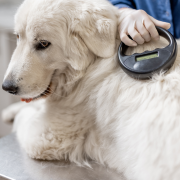June is National Microchipping Month, a reminder for all of us to ensure our pets are microchipped with updated information. Microchipping is an important safeguard to increase the likelihood your pet is returned to you in the event they go missing. Our team of experts has compiled the following information to assist you in learning more about the process and the benefits of microchipping your pet.
A microchip is a small, electronic RFID chip enclosed in a glass cylinder that’s about the same size as a grain of rice. The chip is injected under your pet’s skin, typically between the shoulder blades, and can be implanted during a routine veterinary visit. Once implanted, you register your contact information with the microchip company, and you receive an ID number. All microchip ID numbers can be traced through a universal microchip lookup database regardless the brand of microchip you have.
When scanned, the chip transmits and displays the ID number on the scanner’s screen. Microchips can be scanned by shelters, veterinary clinics, and even animal control officers in the field – who then access the database to aid in searching for the owners.
Microchips should not replace collars with ID tags, license tags, and rabies tags, but collars can fall off or break, so the microchip provides an extra layer of security. Microchips are not GPS devices and cannot track your pet’s location.
When you adopt a dog or cat from Larimer Humane Society, your adoption includes a microchip implant and registration. For other pets, who are not microchipped, we can provide this service for $40. You can also ask your veterinarian to provide microchipping services. You’ll have to make sure your pets are registered with the microchip company, and it’s important that you keep your pet’s microchip information up to date should your contact information ever change.





